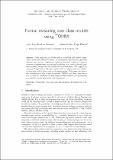Files in this item
Formal reasoning over class models with TOMM
Item metadata
| dc.contributor.author | Mendoza Santana, Juan Jose | |
| dc.contributor.author | Kuster Filipe Bowles, Juliana | |
| dc.date.accessioned | 2019-07-05T08:30:04Z | |
| dc.date.available | 2019-07-05T08:30:04Z | |
| dc.date.issued | 2019-07-15 | |
| dc.identifier | 268335424 | |
| dc.identifier | df0a8c7f-a544-4989-8bb4-b051823ed599 | |
| dc.identifier | 000473336200013 | |
| dc.identifier | 85083399237 | |
| dc.identifier.citation | Mendoza Santana , J J & Kuster Filipe Bowles , J 2019 , ' Formal reasoning over class models with TOMM ' , Journal of Object Technology , vol. 18 , no. 2 . https://doi.org/10.5381/jot.2019.18.2.a12 | en |
| dc.identifier.issn | 1660-1769 | |
| dc.identifier.other | ORCID: /0000-0002-5918-9114/work/59698695 | |
| dc.identifier.uri | https://hdl.handle.net/10023/18047 | |
| dc.description.abstract | Class diagrams are widely used in modelling and system design. They capture the relation between the requirements specification (problem domain) and system components (solution domain). However, constant changes to requirements and manual modelling may result in invalid soft- ware models, and potentially invalid software solutions. We propose an automated approach at the meta-model level to reason about the validity of diagrams and/or their associated requirements. This paper introduces the foundations of the formal framework TOMM, and illustrates how it can be used for validation of class diagram based models, and potentially extended for model generation and comparison. | |
| dc.format.extent | 20 | |
| dc.format.extent | 1180622 | |
| dc.language.iso | eng | |
| dc.relation.ispartof | Journal of Object Technology | en |
| dc.subject | Framework | en |
| dc.subject | Class diagrams | en |
| dc.subject | Requirements | en |
| dc.subject | Formalisation | en |
| dc.subject | Validation | en |
| dc.subject | QA75 Electronic computers. Computer science | en |
| dc.subject | T-NDAS | en |
| dc.subject.lcc | QA75 | en |
| dc.title | Formal reasoning over class models with TOMM | en |
| dc.type | Journal article | en |
| dc.contributor.institution | University of St Andrews. School of Computer Science | en |
| dc.identifier.doi | 10.5381/jot.2019.18.2.a12 | |
| dc.description.status | Peer reviewed | en |
This item appears in the following Collection(s)
Items in the St Andrews Research Repository are protected by copyright, with all rights reserved, unless otherwise indicated.

